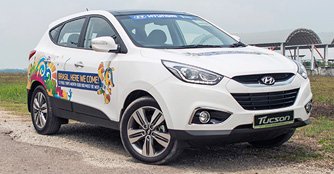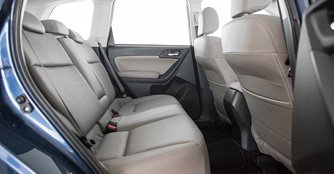Tucson 2.0 (A) vs Forester 2.0i-L (A) vs RAV4 2.0 Premium (A)
23 Apr 2014|52,682 views
It's really a tough job being a car. In these taxing economic times and especially on our little red dot where car prices are sky high, people want a lot more from you, especially those with families.
They're not only demanding for generous space and decent specifications, but all of these on a tight budget too.
This explains why the contenders in the compact SUV segment are working particularly hard to maintain a healthy balance of budget, space and specifications. Here are three of them.
The Hyundai Tucson recently received a facelift to help keep up with the rest in the compact SUV market, among which we have the Subaru Forester and the Toyota RAV4. Both of these SUVs have been top sellers in this segment and were also launched last year in their fourth generations.
And so, we put the Korean up against the two Japanese to see which works better for our local taste buds - kimchi or kimuchi.
Exterior
The revamped Tucson has a subtle-looking sheet metal that is more conservative and inoffensive. More impressively, it receives new LED daytime running lights and taillamps that give off a modern feel.
The Tucson is also the only one that came with 18-inch wheels (the other two competitors came with 17s) as standard. Measuring 4,41mm by 1,820mm by 1,650mm (L x W x H), it is also the smallest of the three compact SUVs.
 |
On the other hand, the Forester looks like it is ready for an adventure anytime, anywhere. Rugged looks and its more angular bodywork allow the car to have a greater on-road presence.
Being the only one equipped with HID headlights and roof rails as standard, there is also a more distinctive look to the Forester.
Among the trio, the RAV4 is the one that is all dressed up for a party. It also comes across as the more mature one, with a handsome raked front similar to that of a man's pompadour hairstyle.
Decked out in modern features such as LED daytime running lights as well as chrome bits, the RAV4 has a whole new look that leaps far from its predecessor.
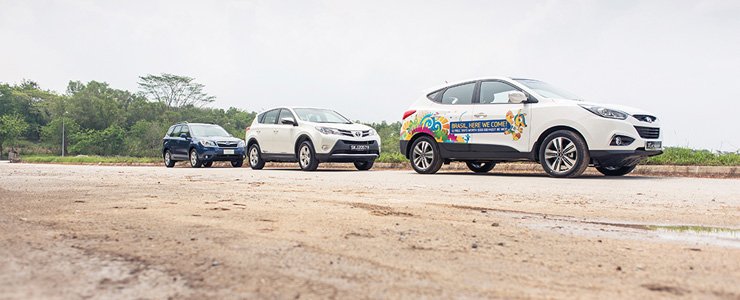 |
Interior
The interior of the Tucson features sound ergonomics and the controls are relatively well-arranged, although we reckon some of the buttons and knobs feel a little tacky.
Plus, it feels like Hyundai kept things a little too basic in the updated Tucson. Features such as manual air-conditioning and a steering rack that is only rake adjustable are still evident here.
Space at the back may be a little of a squeeze for three full-sized adults, but perhaps the space has been transferred to the boot where you will find a whopping 591 litres of capacity.
In comparison, the Forester's cabin boasts higher quality materials and feels much more solid as a whole. It keeps the neat layout of the controls its predecessor used to have. Black insets with a brushed finish also lend a premium feel to the cabin.
There is also an interesting multi-function display located in the centre of the Forester's dash that shows vital car information at a glance. The Forester boasts the most headroom and legroom for passengers, although there is a little compromise on its cargo space of 422 litres.
As for the RAV4, its two-tone interior may not appeal to everyone, but it does liven up the cabin.
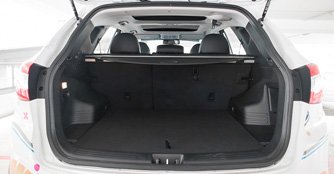
The RAV4's centre console features the most straightforward layout, with buttons and knobs kept to a minimum. There are also modern features such as digital dual-zone air-conditioning as well as a 6.0-inch integrated touchscreen multimedia system - a feature not found on its two competitors.
Boot space in the RAV4 stands at 506 litres and it is also the only one with a power tailgate as standard, making it easier for loading and unloading.
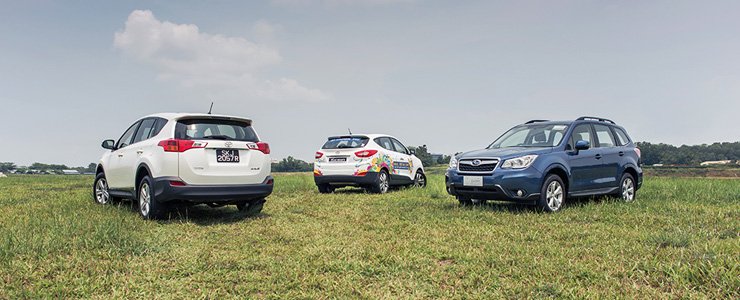 |
The Drive
Powered by a new 2.0-litre 'NU' engine mated to a six-speed automatic transmission, the Tucson is the most energetic on the go. With 153bhp and 191Nm of torque sent to the front wheels, the Tucson goes from standstill to 100km/h in 11.5 seconds, though it feels much quicker in reality.
During our test run, the Tucson returned a fuel efficiency of 9.9km/L, which is not bad, considering it weighs over 1.5 tonnes. It's a rather fun car to throw around, too, as it behaves very much like a smaller car, thanks in part to its smaller dimensions.

On the other hand, the Forester is the most refined of the lot, thanks to the wonderful match of its 2.0-litre Boxer engine and its seven-speed Lineartronic CVT gearbox.
Just like its name, the transmission provides linear gear cogs, allowing the engine to gather enough muster to lug the 1,495kg vehicle from 0 to 100km/h in 11.8 seconds. The CVT transmission also helps in fuel efficiency, and we managed to achieve 10.1km/L with the Forester.
But more importantly, the Forester really shines in its handling department. It responds with absolute accuracy and confidence - a characteristic that isn't common in its segment.
In comparison, the RAV4 does well to keep up with the Forester. Mated to a seven-speed CVT transmission, the 2.0-litre engine may feel a little bit harsh when pushed hard. But once up to speed, the RAV4 is composed and relaxed.
Nonetheless, there wasn't a time when the engine felt breathless and it will still bring the RAV4 to the century mark in a respectable 10.7 seconds.
Fuel efficiency has been a strong point for Toyota vehicles and the RAV4 didn't disappoint either. During our stint with the car, we achieved 10.2km/L, making the RAV4 the most fuel economical one among the three compact SUVs.
Round corners, the RAV4 may be the least adept with slight body roll but it offers the most comfortable ride for its occupants.
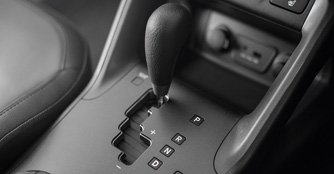
Conclusion
The updated Tucson keeps up with the rest of the pack, offering a refreshed look and a lively performance with an eager character. At $170,999 (as at 10th April 2014), it is rather competitively priced and also has ample features that come along with it.
The Forester sends a signal that it is ready to go off the beaten track before you even step in it. And after getting in, its symmetrical all-wheel drive configuration, along with a suspension setup that gives the car plenty of grip, makes it the most fun to drive in this shootout. Moreover, it costs the least at $154,400 (as at 12th April 2014).
The RAV4 strikes a stunning first impression with its handsome looks, a neat-looking interior and adequate performance. But at $193,988 (as at 14th April 2014), which is $22,989 more than the Tucson and $39,588 more than the Forester, the RAV4 can be a little steep in its price, even if it's the most fuel economical.
With the balance of budget, space and specification taken into consideration, the Forester is the one that deserves our vote, but the Tucson and RAV4 are respectable runner-ups too.
It's really a tough job being a car. In these taxing economic times and especially on our little red dot where car prices are sky high, people want a lot more from you, especially those with families.
They're not only demanding for generous space and decent specifications, but all of these on a tight budget too.
This explains why the contenders in the compact SUV segment are working particularly hard to maintain a healthy balance of budget, space and specifications. Here are three of them.
The Hyundai Tucson recently received a facelift to help keep up with the rest in the compact SUV market, among which we have the Subaru Forester and the Toyota RAV4. Both of these SUVs have been top sellers in this segment and were also launched last year in their fourth generations.
And so, we put the Korean up against the two Japanese to see which works better for our local taste buds - kimchi or kimuchi.
Exterior
The revamped Tucson has a subtle-looking sheet metal that is more conservative and inoffensive. More impressively, it receives new LED daytime running lights and taillamps that give off a modern feel.
The Tucson is also the only one that came with 18-inch wheels (the other two competitors came with 17s) as standard. Measuring 4,41mm by 1,820mm by 1,650mm (L x W x H), it is also the smallest of the three compact SUVs.
On the other hand, the Forester looks like it is ready for an adventure anytime, anywhere. Rugged looks and its more angular bodywork allow the car to have a greater on-road presence.
Being the only one equipped with HID headlights and roof rails as standard, there is also a more distinctive look to the Forester.
Among the trio, the RAV4 is the one that is all dressed up for a party. It also comes across as the more mature one, with a handsome raked front similar to that of a man's pompadour hairstyle.
Decked out in modern features such as LED daytime running lights as well as chrome bits, the RAV4 has a whole new look that leaps far from its predecessor.
Interior
The interior of the Tucson features sound ergonomics and the controls are relatively well-arranged, although we reckon some of the buttons and knobs feel a little tacky.
Plus, it feels like Hyundai kept things a little too basic in the updated Tucson. Features such as manual air-conditioning and a steering rack that is only rake adjustable are still evident here.
Space at the back may be a little of a squeeze for three full-sized adults, but perhaps the space has been transferred to the boot where you will find a whopping 591 litres of capacity.
In comparison, the Forester's cabin boasts higher quality materials and feels much more solid as a whole. It keeps the neat layout of the controls its predecessor used to have. Black insets with a brushed finish also lend a premium feel to the cabin.
The interior of the Tucson features sound ergonomics and the controls are relatively well-arranged, although we reckon some of the buttons and knobs feel a little tacky.
Plus, it feels like Hyundai kept things a little too basic in the updated Tucson. Features such as manual air-conditioning and a steering rack that is only rake adjustable are still evident here.
Space at the back may be a little of a squeeze for three full-sized adults, but perhaps the space has been transferred to the boot where you will find a whopping 591 litres of capacity.
In comparison, the Forester's cabin boasts higher quality materials and feels much more solid as a whole. It keeps the neat layout of the controls its predecessor used to have. Black insets with a brushed finish also lend a premium feel to the cabin.
There is also an interesting multi-function display located in the centre of the Forester's dash that shows vital car information at a glance. The Forester boasts the most headroom and legroom for passengers, although there is a little compromise on its cargo space of 422 litres.
As for the RAV4, its two-tone interior may not appeal to everyone, but it does liven up the cabin.
The RAV4's centre console features the most straightforward layout, with buttons and knobs kept to a minimum. There are also modern features such as digital dual-zone air-conditioning as well as a 6.0-inch integrated touchscreen multimedia system - a feature not found on its two competitors.
Boot space in the RAV4 stands at 506 litres and it is also the only one with a power tailgate as standard, making it easier for loading and unloading.
The Drive
Powered by a new 2.0-litre 'NU' engine mated to a six-speed automatic transmission, the Tucson is the most energetic on the go. With 153bhp and 191Nm of torque sent to the front wheels, the Tucson goes from standstill to 100km/h in 11.5 seconds, though it feels much quicker in reality.
During our test run, the Tucson returned a fuel efficiency of 9.9km/L, which is not bad, considering it weighs over 1.5 tonnes. It's a rather fun car to throw around, too, as it behaves very much like a smaller car, thanks in part to its smaller dimensions.
On the other hand, the Forester is the most refined of the lot, thanks to the wonderful match of its 2.0-litre Boxer engine and its seven-speed Lineartronic CVT gearbox.
Just like its name, the transmission provides linear gear cogs, allowing the engine to gather enough muster to lug the 1,495kg vehicle from 0 to 100km/h in 11.8 seconds. The CVT transmission also helps in fuel efficiency, and we managed to achieve 10.1km/L with the Forester.
But more importantly, the Forester really shines in its handling department. It responds with absolute accuracy and confidence - a characteristic that isn't common in its segment.
In comparison, the RAV4 does well to keep up with the Forester. Mated to a seven-speed CVT transmission, the 2.0-litre engine may feel a little bit harsh when pushed hard. But once up to speed, the RAV4 is composed and relaxed.
Nonetheless, there wasn't a time when the engine felt breathless and it will still bring the RAV4 to the century mark in a respectable 10.7 seconds.
Powered by a new 2.0-litre 'NU' engine mated to a six-speed automatic transmission, the Tucson is the most energetic on the go. With 153bhp and 191Nm of torque sent to the front wheels, the Tucson goes from standstill to 100km/h in 11.5 seconds, though it feels much quicker in reality.
During our test run, the Tucson returned a fuel efficiency of 9.9km/L, which is not bad, considering it weighs over 1.5 tonnes. It's a rather fun car to throw around, too, as it behaves very much like a smaller car, thanks in part to its smaller dimensions.
On the other hand, the Forester is the most refined of the lot, thanks to the wonderful match of its 2.0-litre Boxer engine and its seven-speed Lineartronic CVT gearbox.
Just like its name, the transmission provides linear gear cogs, allowing the engine to gather enough muster to lug the 1,495kg vehicle from 0 to 100km/h in 11.8 seconds. The CVT transmission also helps in fuel efficiency, and we managed to achieve 10.1km/L with the Forester.
But more importantly, the Forester really shines in its handling department. It responds with absolute accuracy and confidence - a characteristic that isn't common in its segment.
In comparison, the RAV4 does well to keep up with the Forester. Mated to a seven-speed CVT transmission, the 2.0-litre engine may feel a little bit harsh when pushed hard. But once up to speed, the RAV4 is composed and relaxed.
Nonetheless, there wasn't a time when the engine felt breathless and it will still bring the RAV4 to the century mark in a respectable 10.7 seconds.
Fuel efficiency has been a strong point for Toyota vehicles and the RAV4 didn't disappoint either. During our stint with the car, we achieved 10.2km/L, making the RAV4 the most fuel economical one among the three compact SUVs.
Round corners, the RAV4 may be the least adept with slight body roll but it offers the most comfortable ride for its occupants.
Conclusion
The updated Tucson keeps up with the rest of the pack, offering a refreshed look and a lively performance with an eager character. At $170,999 (as at 10th April 2014), it is rather competitively priced and also has ample features that come along with it.
The Forester sends a signal that it is ready to go off the beaten track before you even step in it. And after getting in, its symmetrical all-wheel drive configuration, along with a suspension setup that gives the car plenty of grip, makes it the most fun to drive in this shootout. Moreover, it costs the least at $154,400 (as at 12th April 2014).
The RAV4 strikes a stunning first impression with its handsome looks, a neat-looking interior and adequate performance. But at $193,988 (as at 14th April 2014), which is $22,989 more than the Tucson and $39,588 more than the Forester, the RAV4 can be a little steep in its price, even if it's the most fuel economical.
With the balance of budget, space and specification taken into consideration, the Forester is the one that deserves our vote, but the Tucson and RAV4 are respectable runner-ups too.
Car Information
Toyota RAV4 2.0 Premium (A)
CAT B|Petrol|13.3km/L
Horsepower
111kW (149 bhp)
Torque
195 Nm
Acceleration
10.7sec (0-100km /hr)
This model is no longer being sold by local distributor
All Used Toyota RAV4Subaru Forester 2.0i-L (A)
CAT B|Petrol|12.7km/L
Horsepower
110kW (148 bhp)
Torque
198 Nm
Acceleration
11.8sec (0-100km /hr)
This model is no longer being sold by local distributor
All Used Subaru ForesterHyundai Tucson 2.0 (A)
CAT B|Petrol|11.9km/L
Horsepower
113kW (152 bhp)
Torque
191 Nm
Acceleration
-
This model is no longer being sold by local distributor
All Used Hyundai TucsonThank You For Your Subscription.






































